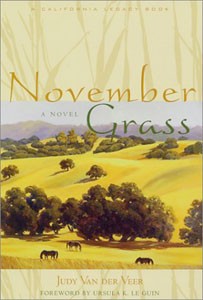Ursula K. Le Guin revives classic novel
By Patrick Sullivan
URSULA K. Le Guin is the undisputed grande dame of American fantasy and science fiction. Over some five decades of writing, she’s published more than 80 short stories and 16 novels, including the Nebula Award-winning The Left Hand of Darkness and the National Book Award-winning Wizard of Earthsea series, which surely ranks with Tolkien’s work among the best-loved classics of fantasy literature.
So what the hell is the nation’s premier chronicler of alternate universes doing championing a novel like November Grass, a coming-of-age story set in Southern California farm country and sporting nary a single alien, wizard, or dragon? And why is Judy Van der Veer’s novel, first published in 1941 and long out of print, now being republished by Heyday Books, a press known for nonfiction explorations of California history?
Both questions have simple answers. November Grass (Heyday; $13.95) is very, very good–the kind of hidden literary treasure that makes a reader wonder how many other gems the publishing industry has buried under its mucky pile of bestsellers. And the book’s author, who spent most of her life on a ranch in San Diego County, provides a vivid, authentic glimpse of a slice of California history now forgotten by all but a few.
In a foreword to the new edition, Le Guin explains that she stumbled across a secondhand copy of November Grass years ago. Le Guin, who has a passion for offbeat projects, quickly recognized the book’s virtues. Moved to buy the battered paperback by the painting of hills on the cover, she was hooked by “a prose so direct, plain, pure, and strong that it slowed me down to savor it like the taste of honey or a fine liqueur, a completely unaffected language perfectly fitted to its subjects.”
A young woman stands at the center of November Grass. We quickly discover that she is strong, quiet, and sensitive. But chapters go by before we find out her age (she’s 23). We never learn her name. Working on her parents’ farm, “the girl”–as she’s referred to throughout–herds cows, rides horses, and reflects deeply on life, love, death, and the elemental beauty of the land.
Because of its simple style, because of its young main character, and especially because of the girl’s intimate relationship with animals, a casual reader might at first mistake November Grass for a children’s book–a mistake often made about some of Le Guin’s own work.
But Van der Veer’s novel is actually a subtle, mature study of life’s beauties and cruelties, glories and mysteries. In setting and style, it’s a bit reminiscent of Steinbeck–but without the brutal axe stroke of a work like The Red Pony. Instead, the book brings its main character slowly but surely to grips with the fundamental questions of existence.
November Grass is composed of deceptively low-key episodes. The girl falls passionately in love with the magical sounds of a piano. She sees a tree magically transformed by shadow and sunlight. She rescues a cow and her calf from the banks of a river during a wild rainstorm. She encounters the eccentrics California has always been known for, including John of the Wilderness, a man who lives in the hills with a herd of goats as his only companions.
And, almost without the reader noticing, she falls for a boy with brown eyes, red hair, and the elegant hands of a sculptor.
It all adds up to a simple classic. For making November Grass available to another generation, Le Guin deserves our thanks. At 71, the Oregon author may not have another Nebula winner in her. But this act of literary resurrection would be a superb crowning accomplishment.
From the June 28-July 4, 2001 issue of the Northern California Bohemian.











